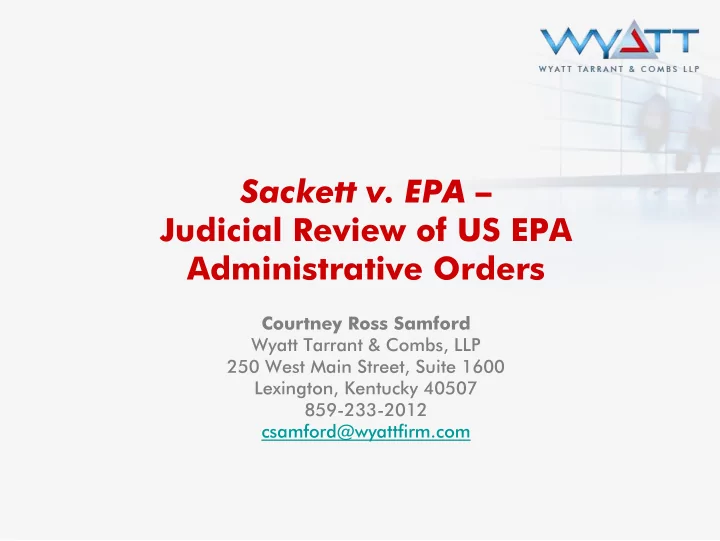

Sackett v. EPA – Judicial Review of US EPA Administrative Orders Courtney Ross Samford Wyatt Tarrant & Combs, LLP 250 West Main Street, Suite 1600 Lexington, Kentucky 40507 859-233-2012 csamford@wyattfirm.com
Overview Factual Background of Sackett Decision U.S. Supreme Court Holding and Rationale Legal Ramifications Recent Guidance on “Waters of the United States”
Factual Background of Sackett Decision
The Sacketts Mike and Chantell Sackett
The Sacketts’ Property Received a building permit in 2007 In late April, they began filling the lot with rock and dirt Immediately stopped by federal officials
EPA’s Position EPA claimed that the Sacketts’ land constituted jurisdictional wetlands under the Clean Water Act (“CWA”) Section 404 of CWA prohibits the discharge of dredged or fill material into wetlands without a permit
EPA’s Position (continued) EPA issued an administrative compliance order to the Sacketts Ordered Sacketts to remove the fill material and restore the property to its original condition Moving the gravel would cost $27,000, which is more than the Sacketts paid for the land Fines up to $75,000 per day Up to $80 million by February, 2012
Hearing Denied Sacketts requested a hearing to challenge the EPA’s determination, but they were denied Sacketts sued the EPA in federal court District Court dismissed case for lack of jurisdiction, finding that pre-enforcement review is not provided by CWA Ninth Circuit Court of Appeals affirmed the district court’s decision Both District Court and Ninth Circuit held that the Sacketts could not contest the compliance order until EPA sued to enforce the penalties
U.S. Supreme Court Holding and Rationale
U.S. Supreme Court Sacketts petitioned the U.S. Supreme Court for review Court granted certiorari on June 28, 2011 Oral arguments held on January 9, 2012
U.S. Supreme Court Ruling Issue: Are landowners entitled to pre- enforcement review of administrative compliance orders? Opinion issued on March 21, 2012 U.S. Supreme Court sided with the Sacketts Unanimous decision Opinion written by Justice Scalia Held that landowners are entitled to pre-enforcement review of administrative compliance orders in a civil action brought under the Administrative Procedure Act (“APA”)
U.S. Supreme Court Ruling (continued) U.S. Supreme Court found that the compliance order was a “final agency action” for purposes of the APA Thus, the Sacketts are entitled to judicial review under the APA since the CWA does not preclude pre-enforcement action Justice Scalia’s opinion: “There is no reason to think the Clean Water Act was uniquely designed to enable the strong-arming of regulated parties into ‘voluntary compliance’ without the opportunity for judicial review.”
U.S. Supreme Court Ruling (continued) Justice Ginsberg’s concurrence Noted that only the EPA’s jurisdictional determination is subject is judicial review Ability to challenge the compliance order itself is still unresolved Justice Alito’s concurrence “The position taken in this case by the Federal Government – a position that the Court now squarely rejects – would have put the property rights of ordinary Americans entirely at the mercy of Environmental Protection Agency (EPA) employees.”
Legal Ramifications of the Sackett Decision
Legal Ramifications Impacts more than just the Sacketts Serious blow to the EPA Speeds up the process because individuals may initiate a challenge
Legal Ramifications Allows other individuals to seek pre-enforcement review of administrative compliance orders that were issued pursuant to: CWA Clean Air Act (“CAA”) Resource Conservation and Recovery Act (“RCRA”) Petitioners are not entitled to pre-enforcement review under Comprehensive Environmental Response, Compensation, and Liability Act (“CERLA”) CERCLA contains an express provision prohibiting pre- enforcement review
Legal Ramifications (continued) EPA staff have been instructed to add language to compliance orders specifying that recipients can challenge the allegations in court before the agency seeks enforcement or penalties EPA is encouraging the use of notices of violations and warning letters prior to the issuance of compliance orders These steps are not “final agency action” EPA may engage in increased negotiations regarding compliance options prior to issuing compliance orders
Recent Guidance on “Waters of the United States”
Importance of “Waters of the United States” CWA applies to any discharge of a pollutant into navigable waters “Navigable waters” is defined as “waters of the United States, including territorial seas” Any expansion of “waters of the United States” will broaden jurisdiction of CWA
Proposed 2011 Guidance Since 1972, the scope of the term “waters of the United States” has been unclear Several proposed guidance documents Subject of several U.S. Supreme Court decisions In April 2011, the EPA and U.S. Army Corps of Engineers (“Corps”) released draft guidance to redefine the term Definition drastically broadened the definition Agencies received 23,000 public comments
What is NOT Subject to CWA Jurisdiction Artificial swimming or reflecting pools Artificially irrigated areas that would revert to upland should irrigation cease Water-filled depressions created incidental to construction
Waters That Are Subject to CWA Jurisdiction Traditional navigable waters; Interstate waters; Wetlands adjacent to either traditional navigable waters or interstate waters: Non-navigable tributaries to traditional navigable waters that are relatively permanent, meaning they contain water at least seasonally; and Wetlands that directly abut relatively permanent waters
Waters That Are Subject to CWA Jurisdiction (continued) Includes the following waters if they have a “significant nexus” to a traditional navigable water or interstate water Tributaries to traditional navigable waters or interstate waters; Wetlands adjacent to jurisdictional tributaries to traditional navigable waters or interstate waters; and Waters that fall under the “other waters” category
Status of Proposed 2011 Guidance EPA and Corps recently submitted final guidance to Office of Management and Budget for federal interagency review Guidance, even if finalized, is not legally binding
Potential Weakness of Recent Guidance EPA and Corps have been criticized for issuing draft guidance instead of engaging in formal rulemaking process Agency guidance documents are entitled to less deference than agency rules by courts Unlikely to resolve the uncertainty surrounding “waters of the United States”
Questions?
Recommend
More recommend